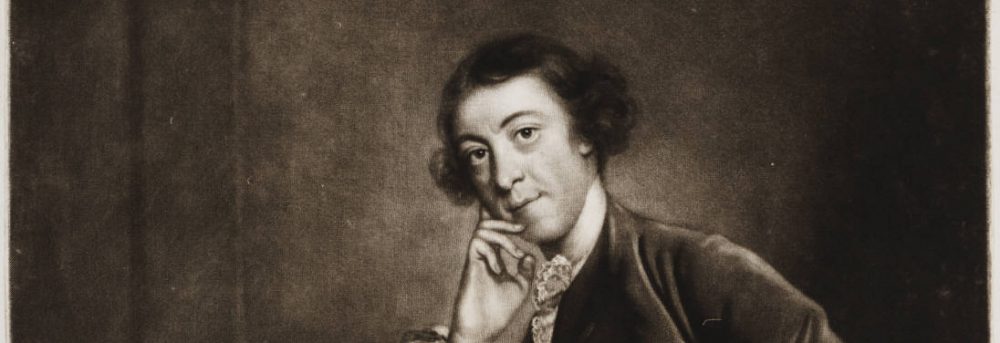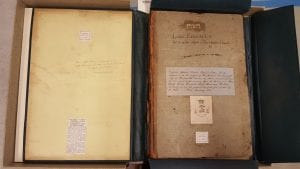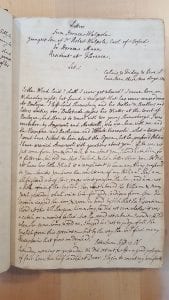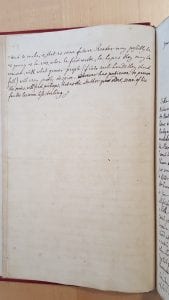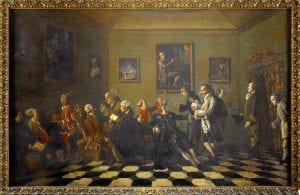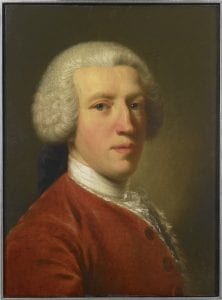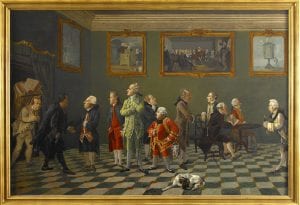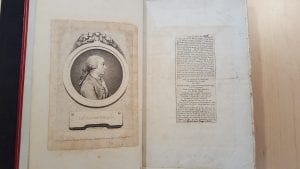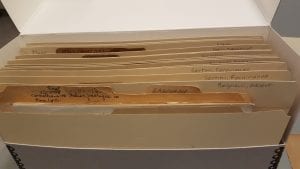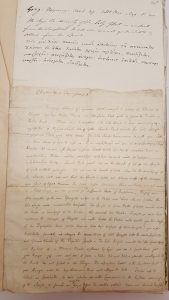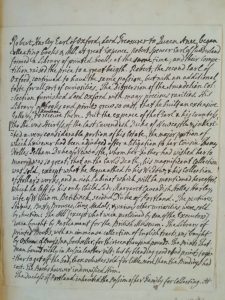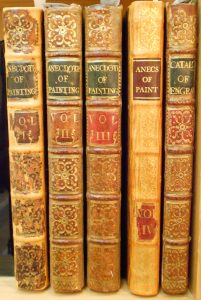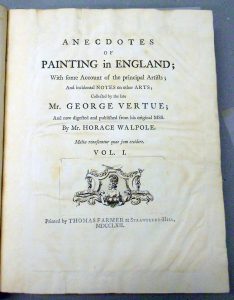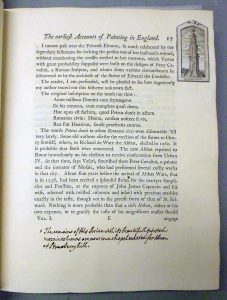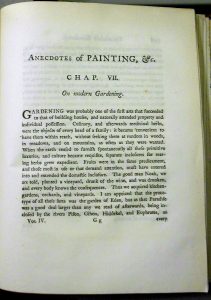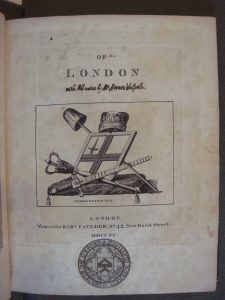Choice 20: Walpole’s Portfolio for His Historic Doubts of the Life and Reign of Richard III
by Wilmarth S. Lewis
“‘It occured to me,’ Walpole wrote in the Preface to his Historic Doubts, ‘that the picture of Richard the Third, as drawn by historians, was a character formed by prejudice and invention. I did not take Shakespeare’s tragedy for a genuine representation, but I did take the story of that reign for a tragedy of imagination. Many of the crimes imputed to Richard seemed improbable; and, what was stronger, contrary to his interest.’
“‘All I mean to show,’ Walpole began, ‘is that though [Richard] may have been as execrable as we are told he was, we have little or no reason to believe so. If the propensity of habit should still incline a single man to suppose that all he has rad of Richard is true, I beg no more, than that person would be so impartial as to own that he has little or no foundation for supposing so.
“‘I will state the list of the crimes charged on Richard; I will specify the authorities on which he was accused; I will give a faithful account of the historians by whom he was accused; and will then examine the circumstances of each crime and each evidence; and lastly, show that some of the crimes were contrary to Richard’s interest, and almost all inconsistent with probability or with dates, and some of them involved in material contradictions.
Supposed Crimes of Richard the Third
1st. His murder of Edward Prince of Wales, son of Henry the Sixth.
2nd. His murder of Henry the Sixth.
3rd. The murder of his brother George Duke of Clarence.
4th. The execution of Rivers, Gray, and Vaughan.
5th. The execution of Lord Hastings.
6th. The murder of Edward the Fifth and his brother.
7th. The murder of his own queen.
“To which may be added, as they are thrown into the list to blacken him, his intended match with his own niece Elizabeth, the penance of Jane Shore, and his own personal deformities.’
“Walpole became convinced as a young man that Richard had been maligned by the Lancastrian and Tudor historians who reported his reign; that is, Richard was an underdog and should be championed. When two eminent antiquarians called his attention to what they believed was the coronation roll, which showed that Edward V., far from having been murdered in the Tower by his uncle Richard, had walked at his coronation, Walpole determined to clear Richard of ‘the mob-stories’ that put him ‘on a level with Jack the giant-killer.’ In his Preface he waved away possible criticism: his attempt, he said, was ‘mere matter of curiosity and speculation’ of an idle man; he was ready to yield to better reasons, but not to ‘”declamation.”‘ Unfortunately, the coronation roll turned out to be a wardrobe account of no relevance. This was disappointing, but it didn’t weaken Walpole’s desire to defend Richard.”
Lewis describes a psychoanalytical theory as to why Walpole got so excited about Richard III and quoted from “a letter to a fellow-antiquary fifteen years after Historic Doubts appeared.
Give me leave in my own behalf to say, that if I am prejudiced, as
probably I am, it is against those historians, not for Richard III. I did
apprehend originally that I should be suspected of the latter, because
when one contests popular prejudices, one is supposed to run into the
contrary extreme. I do believe Richard was a very bad man—but I could
not think him a weak one, which he must have been, had he acted in the
absurd manner imputed to him. I am aware on the other side, that in
so dark and ferocious an age, both he and others may have acted very
differently, and ventured on many steps, that would be preposterous in
a more enlightened time—but then we ought to have very good evidence
of their having done so—and such evidence is very defective indeed.
 “Walpole’s notes for the book are at Farmington. He kept them in the Glass Closet in a portfolio I am rescuing as this Choice. The 1842 Sale Catalogue called it ‘A portfolio containing original letters, deeds, extracts, etc. on the subject of the Historic Doubts on the Life of Richard III, written by Mr Walpole.’ It named some of his correspondents and added that the portfolio contained the proof sheets of the books’ first edition, but it failed to mention Walpole’s notes on the sources he used to write the book. Boone bought the lot for Lord Derby who put it into a linen case. The letters to Walpole about the book were those that Major Milner laid out around the billiard table for me at Knowsley in 1935. He didn’t show me the other manuscripts in the portfolio, but their significance would have been lost on one unfamiliar with the immense complexities of Richard’s story. Maggs bought the lot for me at Sotheby’s in the 1954 Derby Sale. The reviewer of the sale in the Times Literary Supplement singled out the proof sheets, the only Walpolian ones I know of except those for the second edition of the Royal and Noble Authors already mentioned, but Walpole made few corrections in them and they are less interesting that other pieces in the lot.
“Walpole’s notes for the book are at Farmington. He kept them in the Glass Closet in a portfolio I am rescuing as this Choice. The 1842 Sale Catalogue called it ‘A portfolio containing original letters, deeds, extracts, etc. on the subject of the Historic Doubts on the Life of Richard III, written by Mr Walpole.’ It named some of his correspondents and added that the portfolio contained the proof sheets of the books’ first edition, but it failed to mention Walpole’s notes on the sources he used to write the book. Boone bought the lot for Lord Derby who put it into a linen case. The letters to Walpole about the book were those that Major Milner laid out around the billiard table for me at Knowsley in 1935. He didn’t show me the other manuscripts in the portfolio, but their significance would have been lost on one unfamiliar with the immense complexities of Richard’s story. Maggs bought the lot for me at Sotheby’s in the 1954 Derby Sale. The reviewer of the sale in the Times Literary Supplement singled out the proof sheets, the only Walpolian ones I know of except those for the second edition of the Royal and Noble Authors already mentioned, but Walpole made few corrections in them and they are less interesting that other pieces in the lot.
“The portfolio is now in a case worthier of its contents, but they have yet to be studied by a fifteenth-century specialist. His task will not be light, for Walpole jotted down his notes on slips of paper and left them in a general jumble. We’ll see the same casual confusion when we come to his memoirs. Her in the portfolio is a scrap of six by four inches with 46 miscellaneous notes crowded to the martins on both sides. Next is a small card with five notes, including ‘H[enry] 7 did not reverse his Queen’s Bastardy.’ A more extensive note quotes that the late Lord Bolingbroke as saying ‘that the Ambassadors of France and Venice who were present at Richard’s coronation wrote to their respective superiors that Richard was a handsome well made Prince.’ ‘By the favour of the Duchess of Choiseul,’ Walpole wrote, ‘I have had the Depot des affaires étrangères at Versailles carefully examined by the learned and ingenious Abbé Barthelemi, and with the same truth with which I have conducted this inquiry, I must declare that no such account is to be found among the state papers of the King of France. If I discover anything that makes against my own arguments, I shall declare it with the same impartiality. It is indifferent to me on which side the truth may come out, all my aim has been to lead to the discovery of it.’
“There are twelve and a half pages of manuscript references to the Harleian Manuscripts in the British Museum. Walpole listed them from his printed copy of the Catalogue, which came to Farmington from the Library of Congress by exchange. So we have, most happily, not only Walpole’s notes but his annotated source for them. The list of manuscripts has his characteristic crosses and dashes and an occasional ‘See it.'”
Lewis points to evidence that Walpole went to the Museum to view the Harleian Manuscripts.
“Dodsley published twelve hundred copies of Historic Doubts in 1768 and sold them so fast he began printing a second edition of one thousand copies the following day, a remarkable sale for the time. The book is a quarto with two illustrations by Vertue. The original of one of them, Richard and his Queen in its Walpolian frame, came to Farmington from Sotheby’s in 1936. When I got the catalogue of the sale the drawing stood out as a ‘must’ for me, but wat was it worth? This was twenty years before Walpoliana shot into the stratosphere and the limit of £100 that I gave Maggs seemed extravagant, but it proved to be ample, for the drawing was knocked down to us for £2, less than half of what Miss Burdette-Coutts gave for it in 1842. The surviving collectors of the thirties look back to that time as to a lost paradise.
“Historic Doubts caused a furor in the learned world when it appeared, for it is a pioneer work that challenged the traditional picture of Richard as a figure of unmitigated evil. Gray and Cole stood loyally by: Gibbon praised Walpole highly, but shared Hume’s belief that Sir Thomas More’s account of Richard was closer to the truth than Walpole’s. Gibbon’s copy, which Walpole gave to him, is at Farmington, but has, alas, no notes. Among our other eighteen presentation copies are many to Walpole’s antiquarian friends whose notes and comments in their copies will be of interest to future editors of the work, which continues to be, and doubtless always will be, controversial.
“One of the strongest dissidents in 1768 was Dean Jeremiah Milles, President of the Society of Antiquaries, of which Walpole was a member; another was the Rev. Robert Masters. He and Milles expressed their views in Archaeologia, the Society of Antiquaries annual volume, whereupon Walpole rather foolishly resigned from the Society. He printed a Reply to Dean Milles, in six copies only, one of which is at Farmington.”
Lewis recounts Walpole’s response to the criticisms and how he, Lewis, acquired Walpole’s own first twelve volumes of Archaeologia from the Oriental Institute at Luxor, Egypt.
“Therefore Walpole’s set of Archaeologia is not the runner-up kn this Choice, nor is his copy (one of six only) of the Historic Doubts that he printed at the Press in his 1770 Works, even though at the end of it he bound in the manuscript of ‘Postscript to My Historic Doubts, written in Febr. 1793’ that was published in his 1798 Works. The Postscript begins,
It is afflictive to have lived to find in an Age called not only civilized but enlightened, in this eighteenth century, that such horrors, such unparalleled crimes have been displayed on the most conspicuous Theatre in Europe, in Paris, the rival of Athens and Rome. . . . by a Royal Duke, who has actually surpassed all the guilt imputed to Richard the 3d: and who . . . will leave it impossible to any future writer, how ever disposed to candour, to entertain one historic doubt on the abominable actions of Philip Duke of Orleans.
After long plotting the death of his Sovereign, a victim as holy as, and infinitely superior in sense and many virtues to Henry 6th, Orleans has dragged that sovereign to the block, and purchased his execution in public, as in public he voted for it.
 “‘That sovereign’ provided the runner-up in this Choice. When Mme du Deffand received her copy of the book from Walpole she was extasiée, yet not as much as she wished to be because she had no English. She failed to find a translator and died twenty years before the first French translation appeared in 1800. Walpole did not live to see it either, and so missed what I think might have meant more to him than anything else in his life. This was the knowledge that he had indirectly eased the last weeks of the translator as he revised his manuscript while waiting for the mob to come and drag him away to the guillotine. For the first French translator of Historic Doubts of the Life and Reign of Richard III was Louis XVI, and his much worked over manuscript is now at Farmington.
“‘That sovereign’ provided the runner-up in this Choice. When Mme du Deffand received her copy of the book from Walpole she was extasiée, yet not as much as she wished to be because she had no English. She failed to find a translator and died twenty years before the first French translation appeared in 1800. Walpole did not live to see it either, and so missed what I think might have meant more to him than anything else in his life. This was the knowledge that he had indirectly eased the last weeks of the translator as he revised his manuscript while waiting for the mob to come and drag him away to the guillotine. For the first French translator of Historic Doubts of the Life and Reign of Richard III was Louis XVI, and his much worked over manuscript is now at Farmington.
Lewis, Wilmarth S. Rescuing Horace Walpole. New Haven and London: Yale University Press, 1978.
To see the full chapter from Rescuing Horace Walpole called “Choice 20: Walpole’s Portfolio for His Historic Doubts of the Life and Reign of Richard III” download or expand the link here:
 Loading...
Loading...
N.B. For more details about the French translation by Louis XVI, see blog post 10. Doutes Historiques sur la Vie et le Regne de Richard III
.
